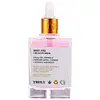What's inside
What's inside
 Key Ingredients
Key Ingredients

 Benefits
Benefits

 Concerns
Concerns

 Ingredients Side-by-side
Ingredients Side-by-side

Aloe Barbadensis Leaf Juice
Skin ConditioningWater
Skin ConditioningCaprylic/Capric Triglyceride
MaskingCannabis Sativa Seed Oil
EmollientLeuconostoc/Radish Root Ferment Filtrate
AntimicrobialLonicera Japonica Flower Extract
Skin ConditioningLonicera Caprifolium Flower Extract
PerfumingPopulus Tremuloides Bark Extract
AntiseborrhoeicGluconolactone
Skin ConditioningPhenoxyethanol
PreservativeGlycerin
HumectantHamamelis Virginiana Water
AstringentMelia Azadirachta Leaf Extract
Skin ConditioningMelia Azadirachta Flower Extract
Skin ConditioningCoccinia Indica Fruit Extract
Skin ConditioningCorallina Officinalis Extract
Skin ConditioningAlcohol
AntimicrobialCarbomer
Emulsion StabilisingTetrasodium Glutamate Diacetate
Euterpe Oleracea Fruit Extract
Sodium Benzoate
MaskingPotassium Sorbate
PreservativeCitric Acid
BufferingHibiscus Rosa-Sinensis Callus Extract
Skin ConditioningBeta Vulgaris Root Extract
Skin ConditioningAlgae Extract
EmollientRetinyl Palmitate
Skin ConditioningCoffea Canephora Seed Extract
EmollientGlycolic Acid
BufferingAloe Barbadensis Leaf Juice, Water, Caprylic/Capric Triglyceride, Cannabis Sativa Seed Oil, Leuconostoc/Radish Root Ferment Filtrate, Lonicera Japonica Flower Extract, Lonicera Caprifolium Flower Extract, Populus Tremuloides Bark Extract, Gluconolactone, Phenoxyethanol, Glycerin, Hamamelis Virginiana Water, Melia Azadirachta Leaf Extract, Melia Azadirachta Flower Extract, Coccinia Indica Fruit Extract, Corallina Officinalis Extract, Alcohol, Carbomer, Tetrasodium Glutamate Diacetate, Euterpe Oleracea Fruit Extract, Sodium Benzoate, Potassium Sorbate, Citric Acid, Hibiscus Rosa-Sinensis Callus Extract, Beta Vulgaris Root Extract, Algae Extract, Retinyl Palmitate, Coffea Canephora Seed Extract, Glycolic Acid
Water
Skin ConditioningCaprylic/Capric Triglyceride
MaskingCetearyl Alcohol
EmollientCetyl Alcohol
EmollientAloe Barbadensis Leaf Juice
Skin ConditioningSqualane
EmollientGlycerin
HumectantDimethicone
EmollientHydroxyethyl Acrylate/Sodium Acryloyldimethyl Taurate Copolymer
Emulsion StabilisingLimnanthes Alba Seed Oil
Skin ConditioningSodium Hyaluronate
HumectantButyrospermum Parkii Butter
Skin ConditioningCetearyl Olivate
Sorbitan Olivate
EmulsifyingArgania Spinosa Kernel Oil
EmollientSodium PCA
HumectantAllantoin
Skin ConditioningIsohexadecane
EmollientCetearyl Glucoside
EmulsifyingPolysorbate 60
EmulsifyingSorbitan Isostearate
EmulsifyingPhenoxyethanol
PreservativeEthylhexylglycerin
Skin ConditioningCitric Acid
BufferingSodium Hydroxide
BufferingWater, Caprylic/Capric Triglyceride, Cetearyl Alcohol, Cetyl Alcohol, Aloe Barbadensis Leaf Juice, Squalane, Glycerin, Dimethicone, Hydroxyethyl Acrylate/Sodium Acryloyldimethyl Taurate Copolymer, Limnanthes Alba Seed Oil, Sodium Hyaluronate, Butyrospermum Parkii Butter, Cetearyl Olivate, Sorbitan Olivate, Argania Spinosa Kernel Oil, Sodium PCA, Allantoin, Isohexadecane, Cetearyl Glucoside, Polysorbate 60, Sorbitan Isostearate, Phenoxyethanol, Ethylhexylglycerin, Citric Acid, Sodium Hydroxide
Ingredients Explained
These ingredients are found in both products.
Ingredients higher up in an ingredient list are typically present in a larger amount.
Aloe Barbadensis Leaf Juice comes from leaves of the aloe plant. Aloe Barbadensis Leaf Juice is best known for helping to soothe sunburns. It is also anti-inflammatory, moisturizing, antiseptic, and can help heal wounds.
Aloe is packed with good stuff including Vitamins A, C, and E. These vitamins are antioxidants, which help fight free-radicals and the damage they may cause. Free-radicals are molecules that may damage your skin cells, such as pollution.
Aloe Barbadensis Leaf Juice also contains sugars. These sugars come in the form of monosaccharides and polysaccharides, folic acid, and choline. These sugars are able to help bind moisture to skin.
It also contains minerals such as calcium, 12 anthraquinones, fatty acids, amino acids, and Vitamin B12.
Learn more about Aloe Barbadensis Leaf JuiceThis ingredient is an emollient, solvent, and texture enhancer. It is considered a skin-softener by helping the skin prevent moisture loss.
It helps thicken a product's formula and makes it easier to spread by dissolving clumping compounds.
Caprylic Triglyceride is made by combining glycerin with coconut oil, forming a clear liquid.
While there is an assumption Caprylic Triglyceride can clog pores due to it being derived from coconut oil, there is no research supporting this.
Learn more about Caprylic/Capric TriglycerideCitric Acid is an alpha hydroxy acid (AHA) naturally found in citrus fruits like oranges, lemons, and limes.
Like other AHAs, citric acid can exfoliate skin by breaking down the bonds that hold dead skin cells together. This helps reveal smoother and brighter skin underneath.
However, this exfoliating effect only happens at high concentrations (20%) which can be hard to find in cosmetic products.
Due to this, citric acid is usually included in small amounts as a pH adjuster. This helps keep products slightly more acidic and compatible with skin's natural pH.
In skincare formulas, citric acid can:
While it can provide some skin benefits, research shows lactic acid and glycolic acid are generally more effective and less irritating exfoliants.
Most citric acid used in skincare today is made by fermenting sugars (usually from molasses). This synthetic version is identical to the natural citrus form but easier to stabilize and use in formulations.
Read more about some other popular AHA's here:
Learn more about Citric AcidGlycerin is already naturally found in your skin. It helps moisturize and protect your skin.
A study from 2016 found glycerin to be more effective as a humectant than AHAs and hyaluronic acid.
As a humectant, it helps the skin stay hydrated by pulling moisture to your skin. The low molecular weight of glycerin allows it to pull moisture into the deeper layers of your skin.
Hydrated skin improves your skin barrier; Your skin barrier helps protect against irritants and bacteria.
Glycerin has also been found to have antimicrobial and antiviral properties. Due to these properties, glycerin is often used in wound and burn treatments.
In cosmetics, glycerin is usually derived from plants such as soybean or palm. However, it can also be sourced from animals, such as tallow or animal fat.
This ingredient is organic, colorless, odorless, and non-toxic.
Glycerin is the name for this ingredient in American English. British English uses Glycerol/Glycerine.
Learn more about GlycerinPhenoxyethanol is a preservative that has germicide, antimicrobial, and aromatic properties. Studies show that phenoxyethanol can prevent microbial growth. By itself, it has a scent that is similar to that of a rose.
It's often used in formulations along with Caprylyl Glycol to preserve the shelf life of products.
Water. It's the most common cosmetic ingredient of all. You'll usually see it at the top of ingredient lists, meaning that it makes up the largest part of the product.
So why is it so popular? Water most often acts as a solvent - this means that it helps dissolve other ingredients into the formulation.
You'll also recognize water as that liquid we all need to stay alive. If you see this, drink a glass of water. Stay hydrated!
Learn more about Water